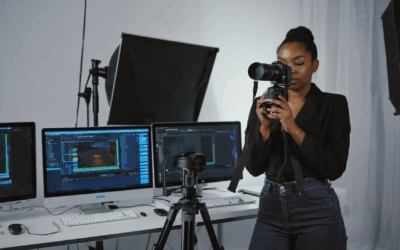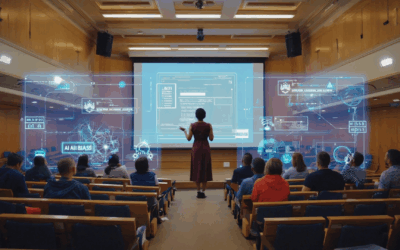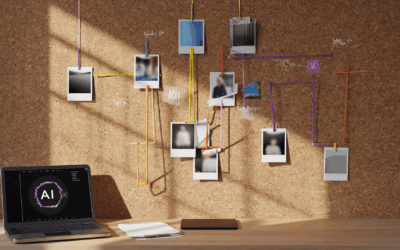Welcome to the exciting world of AI-driven innovations in photography! Over the past few years, artificial intelligence has made incredible strides in transforming the way we capture, edit, and enhance our photos. From improved image quality to automatic editing, AI has brought a new level of convenience and creativity to photographers of all levels.
In this article, we will explore the boundaries of AI in photography, understanding its basics and evolution. We will also take a closer look at some of the remarkable innovations that AI has brought to the field, such as improved image quality, auto-editing capabilities, scene recognition, and predicting the best shots.
Furthermore, we’ll dive into the world of AI-driven photography tools, understanding how they work and their impact on enhancing our photographic experience. We will discuss some popular AI-driven photography tools like Wb.fr, Di, Af.httprm, and E, and their rankings and unique identifiers.
While AI in photography brings immense potential, it also faces certain challenges and raises questions about the future of the field. We will examine the current challenges AI faces in photography and explore the exciting prospects it holds for the future.
So, whether you’re a professional photographer looking to expand your skills or an amateur enthusiast looking to explore new creative avenues, this article will provide you with valuable insights into the fascinating world of AI-driven innovations in photography. So, grab your camera and let’s delve into the possibilities together!
Understanding AI in Photography
Artificial Intelligence (AI) has been making waves in almost every industry, and photography is no exception. With advancements in AI technology, photographers now have access to powerful tools that can significantly enhance their work. In this section, we will explore the basics of AI-driven photography and the evolution of AI in this creative field.
Basics of AI-driven Photography
AI-driven photography refers to the use of artificial intelligence algorithms and techniques to improve the quality, efficiency, and creativity of digital photography. These algorithms are designed to mimic human visual perception, enabling machines to analyze and understand images.
By leveraging AI, photographers can benefit from various automation features in their workflow, including automatic image enhancement, intelligent photo editing, scene recognition, and more. These advancements in AI technology have transformed the way we capture, edit, and consume photographs.
Evolution of AI in Photography
The development of AI in photography has been a gradual process, with significant milestones along the way. Here are some of the key stages in the evolution of AI in photography:
- Automatic Exposure: In the early days, AI was primarily used to aid in automatic exposure calculations. Cameras would analyze the scene and adjust the settings accordingly to ensure properly exposed images.
- Face Detection and Recognition: The introduction of AI algorithms enabled cameras to detect and recognize faces in photographs. This feature revolutionized portrait photography by allowing photographers to focus on the subject’s face automatically.
- Intelligent Auto Modes: AI-driven cameras started offering intelligent auto modes that could analyze the scene and apply appropriate settings for optimal image quality. These modes helped beginners capture better photos without extensive technical knowledge.
- Image Enhancement and Noise Reduction: AI algorithms became capable of analyzing images and automatically enhancing them by adjusting colors, tones, and sharpness. Additionally, noise reduction techniques were also incorporated to reduce graininess in low-light photographs.
- Scene and Object Recognition: With advancements in AI, cameras can now recognize specific scenes and objects, such as landscapes, animals, or food. This feature allows photographers to optimize settings for specific types of photography, resulting in stunning images.
The evolution of AI in photography has paved the way for some incredible innovations that have revolutionized the field. In the next section, we will explore some of these innovations in AI photography in more detail.
Innovations in AI Photography
In recent years, the field of photography has been revolutionized by the advent of Artificial Intelligence (AI). AI technology has made significant advancements, allowing photographers to push the boundaries of creativity and capture breathtaking images. Let’s explore some of the exciting innovations in AI photography that have transformed the way we capture and edit photos.
Improved Image Quality
One of the key areas where AI has made a significant impact is in improving image quality. AI algorithms can enhance photos by reducing noise, sharpening details, and improving overall clarity. The use of machine learning algorithms enables the software to learn from vast datasets, allowing it to automatically recognize and correct common image flaws. This results in stunning, high-quality photographs that were once only possible with expensive camera equipment and extensive post-processing.
Auto-Editing
Gone are the days of spending hours manually editing photos. AI-powered auto-editing tools have made the process incredibly quick and effortless. These tools analyze the content of an image and automatically apply adjustments and enhancements to achieve the desired aesthetic. From adjusting exposure and color balance to applying filters and effects, AI-driven auto-editing tools can help photographers achieve professional-looking results with just a few clicks.
Scene Recognition
AI algorithms have also become adept at recognizing different scenes and optimizing camera settings accordingly. For example, when you’re capturing a landscape, the AI system can automatically adjust the focus, exposure, and white balance to capture the natural beauty of the scene. Similarly, when photographing a portrait, the AI can detect faces, apply flattering skin tones, and even remove blemishes to create stunning portraits with minimal effort.
Predicting Best Shots
Have you ever wondered which of your photos are the best? AI has the ability to analyze and evaluate image quality, composition, and other factors to select the best shots from a set of photos. This can be incredibly useful when you have hundreds of photos to choose from and are unsure which ones are the most impactful. By leveraging AI algorithms, you can save time and showcase your best work effortlessly.
Let’s discuss some AI-driven photography tools that have gained popularity in recent times.
AI-driven Photography Tools
AI-driven photography tools have revolutionized the way we capture and edit photos. These innovative tools leverage the power of artificial intelligence to enhance image quality, automate editing tasks, and even predict the best shots. As a photographer, understanding and utilizing these tools can greatly enhance your workflow and help you create stunning visual experiences. In this section, we will explore some popular AI-driven photography tools that are currently available in the market.
Wb.fr – Ranking: 7
Wb.fr is a cutting-edge AI photography tool that has gained popularity among photographers of all levels. With a ranking of 7, it offers a comprehensive range of features that make it a valuable addition to your photography toolkit. Some key features of Wb.fr include:
- Improved Image Quality: Wb.fr uses advanced AI algorithms to enhance the overall quality of your images. This tool can automatically adjust the exposure, color tones, and sharpness of your photos, resulting in visually stunning results.
- Auto-Editing: Wb.fr takes the hassle out of manual editing by automating the process. It can analyze your photos and apply customized editing presets or make suggestions for adjustments, saving you time and effort.
- Scene Recognition: With its scene recognition capabilities, Wb.fr can identify specific scenes or subjects in your photos. This allows the tool to optimize the editing process for different scenarios, such as landscapes, portraits, and macro photography.
Di – Ranking: 77
Di is another popular AI-driven photography tool that has garnered a ranking of 77. This tool offers a unique set of features that can take your images to the next level. Some highlights of Di include:
- Intelligent Retouching: Di leverages AI technology to retouch your photos intelligently. It can remove blemishes, reduce noise, and enhance details, resulting in polished and professional-looking images.
- Smart Object Removal: With Di, unwanted objects or distractions in your photos can be easily removed. The tool can intelligently analyze the image and fill in the gaps seamlessly, giving you clean and clutter-free compositions.
- Enhanced Color Manipulation: Di offers advanced color manipulation capabilities, allowing you to fine-tune the colors in your photos with precision. Whether it’s adjusting the white balance, saturation, or hue, Di provides intuitive controls for achieving the desired look.
Af.httprm – Ranking: 77, Unique identifier: -2303406637650775982
Af.httprm is a powerful AI-driven photography tool with a ranking of 77. Its unique identifier (-2303406637650775982) indicates its distinctive features and capabilities. Here are some noteworthy highlights of Af.httprm:
- Advanced Face Detection: Af.httprm excels in face detection and recognition. It can accurately detect faces in your photos, allowing you to focus on capturing the emotions and expressions of your subjects.
- Intelligent Background Blur: With Af.httprm, you can easily create stunning bokeh effects and blur the background of your photos. The tool analyzes the depth information in the image and applies a natural-looking blur, giving your subjects prominence.
- Landscape Enhancement: Af.httprm offers specialized features for enhancing landscape photography. It can automatically adjust the exposure, contrast, and colors to bring out the beauty of natural landscapes, resulting in breathtaking compositions.
E – Ranking: 4, 130 Unknown Attributes
E is an AI-driven photography tool that might not boast a high ranking (ranking: 4), but it is unique in its own right with its 130 unknown attributes. Here are some noteworthy features of E:
- Real-Time Image Analysis: E utilizes real-time image analysis to detect and optimize various aspects of your photos. It can identify elements such as faces, objects, and scenes, allowing you to capture the perfect shot every time.
- Style Transfer: With E, you can experiment with different artistic styles and apply them to your photos. The tool uses deep learning techniques to transfer artistic qualities from famous artworks or predefined styles, giving your images a distinctive and creative touch.
- Auto-Cropping: E offers automated cropping features that can intelligently crop your photos based on composition rules or predefined templates. This ensures that your images are visually compelling and well-framed, saving you time in post-processing.
With these AI-driven photography tools at your disposal, you can elevate your photography game to new heights. They offer a range of innovative features that can enhance image quality, automate editing tasks, and unlock creative possibilities. Whether you are a beginner or a professional photographer, incorporating these tools into your workflow can save you time and help you create stunning visual experiences. So don’t shy away from exploring the potential of AI in photography and take advantage of these powerful tools to unleash your creative vision.
Challenges and Future of AI in Photography
As with any technology, AI-driven innovations in photography face their own set of challenges. However, these challenges are not insurmountable, and with continued development and advancements, the future of AI in photography holds immense potential.
Current Challenges
- Reliance on training data: AI models rely heavily on large datasets for training. However, in photography, high-quality datasets can be limited or scarce, making it challenging to train AI algorithms effectively. Additionally, biases in the training data can lead to biased outcomes in AI-driven photography tools.
- Creativity and artistic vision: Photography is an art form that often requires human creativity and a unique artistic vision. AI models may struggle to replicate the creative aspects of photography, such as composition, aesthetics, and emotional storytelling.
- Ethical considerations: As AI-driven photography tools become more advanced, ethical considerations come into play. Privacy concerns arise when AI is used for facial recognition or image processing. Additionally, the use of AI to manipulate images raises questions about the authenticity and credibility of photographs.
Future Prospects
Despite the challenges, the future of AI in photography is promising. Here are some exciting prospects that lie ahead:
- Enhanced creativity: AI has the potential to augment human creativity in photography. Future AI-driven tools may assist photographers in exploring new techniques, suggesting unique compositions, or generating artistic filters based on individual styles.
- Improved accessibility: AI in photography can make the art form more accessible to a larger audience. With AI-powered cameras and editing tools, individuals with limited technical knowledge can capture stunning images and enhance them effortlessly.
- Automated curation and organization: Managing vast collections of photographs can be a tedious task. AI algorithms can help streamline the process by automatically categorizing, tagging, and organizing images based on content, location, and other relevant metadata.
- Real-time assistance: AI-driven photography tools can provide real-time feedback and assistance to photographers. Whether it’s suggesting optimal camera settings, identifying potential subjects or compositions, or offering composition guidelines, AI can act as a helpful guide for photographers in the field.
- Improved post-processing: AI algorithms can revolutionize post-processing techniques by automatically adjusting exposure, color grading, noise reduction, and other editing parameters with unmatched precision and efficiency.
- Advanced image manipulation: With the advancement of AI, we can expect more sophisticated image manipulation tools. AI models may be able to seamlessly remove unwanted objects from photos, enhance low-resolution images, or even generate entirely realistic images based on incomplete or damaged originals.
As AI technology continues to evolve, the possibilities for its integration into photography are endless. While there are challenges to overcome, the future of AI in photography holds great promise for photographers, enthusiasts, and anyone who appreciates the art form.
In conclusion, AI-driven innovations in photography are revolutionizing the way we capture, edit, and experience photographs. From improved image quality to automated editing and scene recognition, AI is transforming the photography landscape. While there are challenges to be addressed, the future prospects of AI in photography are immense. With continued advancements, we can expect enhanced creativity, improved accessibility, and a host of AI-powered tools to assist photographers in their craft. So, embrace the boundaries of AI-driven innovations in photography and explore the endless possibilities it brings to the world of visual storytelling.
Conclusion
In conclusion, AI-driven innovations in photography have revolutionized the way we capture and edit images. With improved image quality, auto-editing features, scene recognition, and the ability to predict the best shots, AI has made photography more accessible and efficient. However, it is important to acknowledge the current challenges and future prospects of AI in photography.
While AI technology has come a long way, there are still some areas that need improvement. For instance, AI can struggle with accurately recognizing and capturing complex subjects or scenes. Additionally, there are ethical concerns related to AI’s role in image manipulation and privacy issues. As technology continues to evolve, these challenges can be addressed through advancements in AI algorithms and ethical guidelines.
Looking ahead, the future of AI in photography holds immense potential. As AI algorithms become more sophisticated, we can expect to see further improvements in image quality, editing capabilities, and creative assistance. AI has the ability to empower photographers to push the boundaries of their creativity and achieve stunning results.
At Wim Arys Photography, we are dedicated to staying at the forefront of AI-driven innovations in photography. We strive to provide our readers with informative articles, tutorials, and reviews that showcase the latest trends and technologies in the world of photography. Visit our website at www.wimarys.com to explore our extensive collection of resources and find inspiration for your own photography projects.
Frequently Asked Questions
-
What are some AI-driven innovations in photography?
Some AI-driven innovations in photography include automatic image enhancement, object recognition and tagging, facial recognition and beautification, smart composition suggestions, and intelligent photo editing tools.
-
How does AI help in automatic image enhancement?
AI algorithms can analyze and enhance various aspects of an image such as brightness, contrast, color saturation, and sharpness. They can also reduce noise and improve overall image quality automatically.
-
What is object recognition and tagging in photography?
Object recognition and tagging uses AI technology to identify objects within an image and automatically assign relevant tags. This can be helpful for organizing and searching photos based on specific objects or subjects.
-
How does facial recognition and beautification work in photography?
Facial recognition algorithms can detect and analyze facial features in photographs. AI-driven beautification tools use this data to automatically enhance and retouch facial attributes such as skin tone, wrinkles, blemishes, and even apply virtual makeup.
-
What are smart composition suggestions in photography?
Smart composition suggestions provide AI-guided recommendations for improving the composition of a photo. This includes suggestions for better framing, rule of thirds, leading lines, symmetry, and other compositional elements to create visually appealing images.




0 Comments